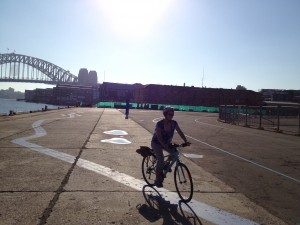
Wandering around Sydney’s CBD, as I do on a daily basis, you will always find pedestrians completely ignoring road rules. They cross the road against the traffic lights, or when there are no lights at all. They will walk around barriers designed to force them to cross at the lights, and weave in and out of stalled traffic.
To a pedestrian, motorists, on the other hand, are pretty law-abiding. It’s very rare that I see motorist break a rule that makes me scared to be crossing a road.
But cyclists? Cyclists have the rough end of the stick in all directions. Pedestrians think cyclists are maniacs who break every rule possible (despite breaking even more). Cyclists think that motorists are maniacs (despite motorists being much more law-abiding than pedestrians.
As the Invisible Visible Man points out, it is all about perception and reality of risk.
Pedestrians know that by disobeying the rules, they are generally harming no-one but themselves. If they jump out in front of a moving car, they are generally going to come off worse. So many people are quite comfortable disobeying the rules, and taking risks for themselves.
Motorists know that disobeying the rules could have disastrous consequences. More to the point, so do the enforcers of those rules, so over many years, mostly our culture has been that you obey the rules.
But we have a problem. The perceptions don’t work for cyclists. The Invisible Visible man:
The problem appears to be a widespread one. In the UK, newspaper reporting about the crash that injured Bradley Wiggins – one of my great heroes – ended up producing the same, predictable commentary claiming cyclists endanger pedestrians and, somehow, cars. That’s even though the Tour de France winner’s accident involved his colliding with a car that seems to have pulled out into his path from a filling station without looking. In other words, people started complaining on the basis of the kind of accident that happens quite a lot (one where a negligent motorist injures a cyclist) about things that hardly ever happen – accidents where cyclists hurt other road users.
Fifteen years ago, I was knocked over by a cyclist in Sydney’s CBD. I was on the footpath, he was racing down Martin Place. I was bruised and sore for a couple of days, but was otherwise fine. That is a classic example of the type of accident people complain about when they complain about cyclists and pedestrians. But in stark contrast to Bradley Wiggins, I didn’t spend a night in hospital, or break any bones. Even though the bike was moving faster than me, it was a fairly equal collision.
According to this research paper, when the RTA analysed 10 years of injuries in bicycle accidents in Sydney’s CBD (1,003 total accidents), 71 involved bicycles hitting pedestrians stepping into their path, and 14 involved pedestrians on footpaths, that’s 8% of the total.
Bicycle accidents are substantially underreported, but the accidents in the analysis are likely to be the most serious. And clearly the risk of a bicycle accident is much greater to the cyclist than the pedestrian.
That same research paper comes up with a range of suggestions, but most of them are, fundamentally, about familiarity. The more familiar people are with people travelling using other modes, the less likely they are to treat them as the “other”.
The Invisible Visible man again:
That anyone could ever have thought the Washington stabbing [ the stabbing of a motorist by a cyclist] had anything to do with broader cyclist behaviour, of course, stems from humans’ powerful desire to pin blame for problems on out-groups. The only thing so far known about the Washington motorist’s assailant is that he was on a means of transport against which large numbers of people have powerful prejudices. Few people have the mental self-discipline to avoid working on the basis of such limited information and their prejudices to jump to wholly unwarranted conclusions.
People get statistics wrong all the time. And they particularly get them wrong when they are unfamiliar. So remember, if you are a pedestrian, annoying bikes are unlikely to hurt you badly. And if you are a motorist, please be careful around bikes, they are much more likely to be hurt by you than the other way around. And of course, bikes, obey the rules. Just as with any non dominant group, people judge the entire group by your behaviour. It may be unfair, but it is the way it works.

doesnt it come down to accountability? motorist are registered, but pedestrains and cyclist are not.
i think its more stick than carrot….bring on compulsory registration for bicycles!
Did you read the article?